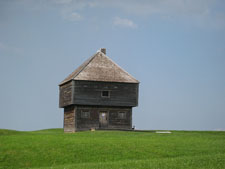Fort
Edward National Historic Site
Fort Edward is now a national historic site in Nova
Scotia, Canada and was constructed in Father LeLoutre's War, and to
assist in preventing the Acadian exodus from the island, but is most
famous for its part in the Expulsion of the Acadians in 1755 and in
protecting Halifax from a land assault in the American Revolution.
Quite a bit of it would be burned down in 1922, the blockhouse that
still stands is one of the oldest in North America, with a cairn
later added. Although the British would conquer Acadia in 1710, Nova
Scotia would continue to be occupied by the Catholic Acadians and
Mi'kmaq Indians; and Father Le Loutre's War started when Edward
Cornwallis came to establish Halifax in 1749 with 13 transports. By
building Halifax, the British violated the earlier treaties that
they had signed with the Mi'kmaq nation in 1726 that had been signed
after Dummer's War. The English would begin building other
settlements around the island, and to guard against Mi'kmaq, French
or Acadian attacks on the new protestant settlements, the British
would construct a fort in Halifax, taking full control of the
peninsula. Fort Edward would become the site of the Acadian church
for the parish of l'Assomption in 1722, and after failing to take
control of the settlements of Chignecto, Major Charles Lawrence
would order his New England rangers to take control of Pisquid, as
it was called back then, by encouraging the Acadians to burn down
their church so Fort Edward could be constructed on its site in
1750. Hoping to accomplish this, the rangers would engage the
Mi'kmaqs at the Battle of St. Croix in the same year. The fort would
be named after Cornwallis since he established Halifax, Nova Scotia.
It would play a further significant role in the Bay of Fundy
Campaign in 1755 that began the Acadian Expulsion, while the British
jailed those Acadians in the church at Grand Pre, as well as jailing
183 Acadian men in Fort Edward until they could be deported. The
fort would be involved in the French and Indian War, the American
Revolution, the War of 1812, and WWI.
|

